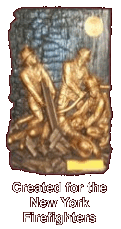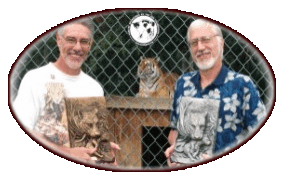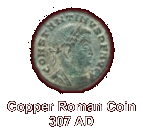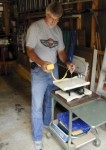  |
3
|
There
is one technique in which they use inorganic pigments layered
on Mylar that has an estimated longevity of 500 years without
fading. Of course there is fired ceramic which employs much
the same technique.
New
technology produces longevity and exquisite prints. But prints
can be easily destroyed and ceramics easily broken. Unlike
my resin sculptures, these options, to me at least, still had
down sides. I wanted more longevity as well as an indestructible
nature. Sure, that’s going to be easy.
I
met Carl Regutti in the late summer of 2001. I saw a piece
of his work on display at a local trophy shop. It happened
to be one of his prototype firefighter pieces, a preview of "Heroism & Sacrifice",
a life-size bronze, granite, and concrete monument honoring
North Carolina's fallen firefighters now on display in Nash
Square in Raleigh, NC.
 I
called Carl and asked if he would be interested in doing a
piece for the Zoe Foundation. We arranged a meeting and the
rest is history. We both worked on the design of “Survival
at Risk”, the bas-relief Carl created for the foundation.
We frequently got together to brainstorm ideas. His sculptures
have longevity, but Carl was also interested in large architectural
work using a new product he had been researching, colored stainless
steel. It comes in some wonderful colors, and if one uses 316
L stainless it will survive the elements almost indefinitely.
I
called Carl and asked if he would be interested in doing a
piece for the Zoe Foundation. We arranged a meeting and the
rest is history. We both worked on the design of “Survival
at Risk”, the bas-relief Carl created for the foundation.
We frequently got together to brainstorm ideas. His sculptures
have longevity, but Carl was also interested in large architectural
work using a new product he had been researching, colored stainless
steel. It comes in some wonderful colors, and if one uses 316
L stainless it will survive the elements almost indefinitely.
For
comparison, think about this. There are copper and bronze coins
having clearly  defined
images that have been around for thousands of years. These
materials both oxidize fairly proficiently. But that’s
how they survived. Virtually all ancient bronze coins have
at least a thin layer of brown oxide directly on the metal
surface. The oxide layer protected the base metal. Stainless
steel, especially 316 L, is designed for optimal corrosion
resistance, even in a salt laden atmosphere. How long do you
think a .060 (1/16
defined
images that have been around for thousands of years. These
materials both oxidize fairly proficiently. But that’s
how they survived. Virtually all ancient bronze coins have
at least a thin layer of brown oxide directly on the metal
surface. The oxide layer protected the base metal. Stainless
steel, especially 316 L, is designed for optimal corrosion
resistance, even in a salt laden atmosphere. How long do you
think a .060 (1/16  inch)
piece of natural 316 L will survive? How long with a hot immersion
produced oxide layer and a clear porcelain, amorphous diamond,
or fluorinated polyurethane top coating (applied for scratch
resistance)?
inch)
piece of natural 316 L will survive? How long with a hot immersion
produced oxide layer and a clear porcelain, amorphous diamond,
or fluorinated polyurethane top coating (applied for scratch
resistance)?
Carl
asked if I thought we could somehow put photo realistic images
on the coated stainless. I didn’t know anything about
that. I worked with paper and printers. But Carl showed me  some
stainless that had been imaged in Japan. The Japanese are leaders
in this area. So it could be done. But their resolution wasn’t
impressive. We came to find out recently that they were getting
65 to 85 lines per inch. Carl and I both figured if it could
be done we could develop a way to do it better. And that’s
exactly what we did.
some
stainless that had been imaged in Japan. The Japanese are leaders
in this area. So it could be done. But their resolution wasn’t
impressive. We came to find out recently that they were getting
65 to 85 lines per inch. Carl and I both figured if it could
be done we could develop a way to do it better. And that’s
exactly what we did.
Carl
and I come from diversified backgrounds. We both hold US patents,
but Carl is a chemist and a sculptor. I am a graphics designer,
builder, inventor, and preservationist. Together we complement
each other. We started out in what we humbly like to call our “lab” – actually
Carl’s overloaded garage. We occasionally think of ourselves
as somewhat like the Wright Brothers, who inaugurated an industry
and forever changed perceptions. And all that began in a bicycle
shop.
  |
3
|